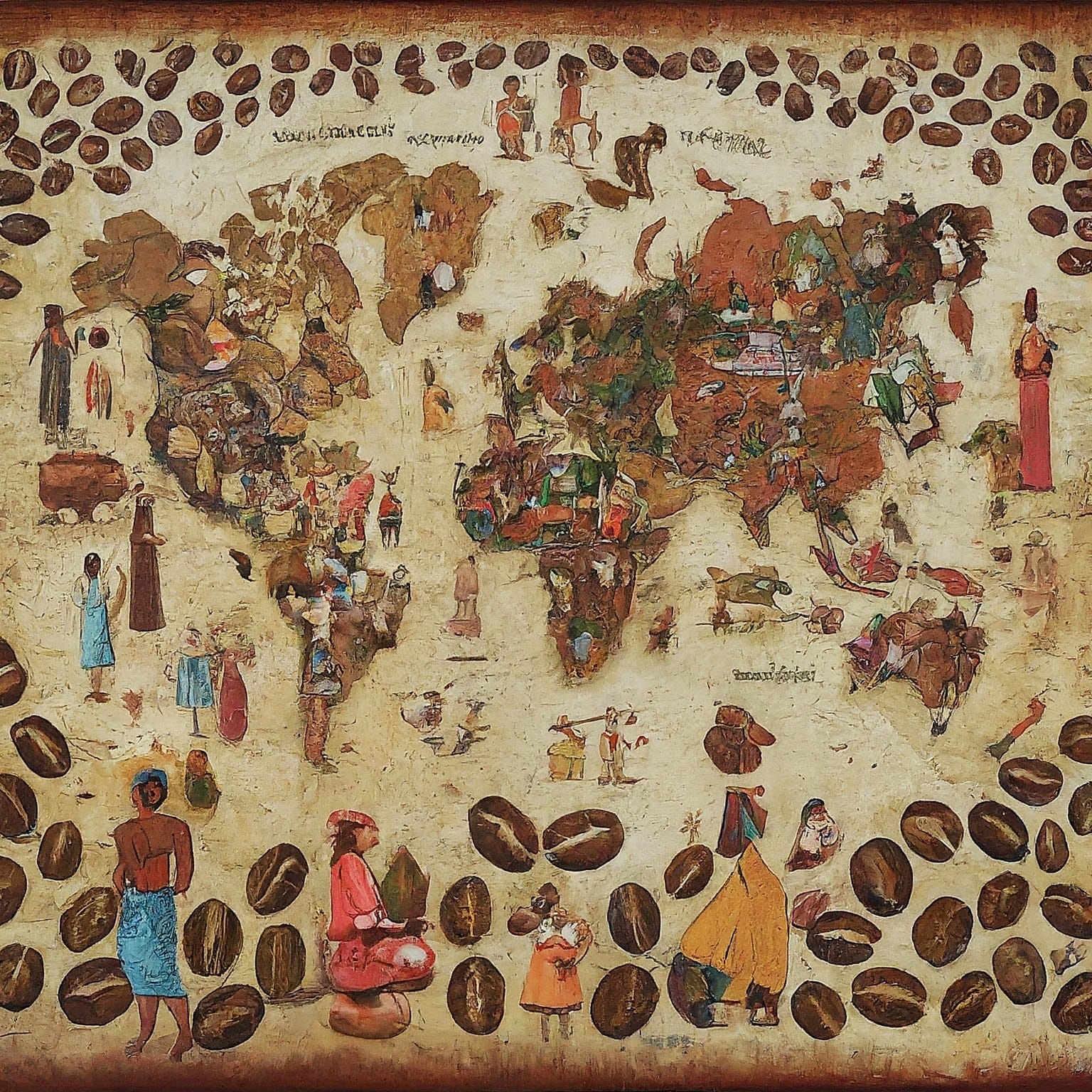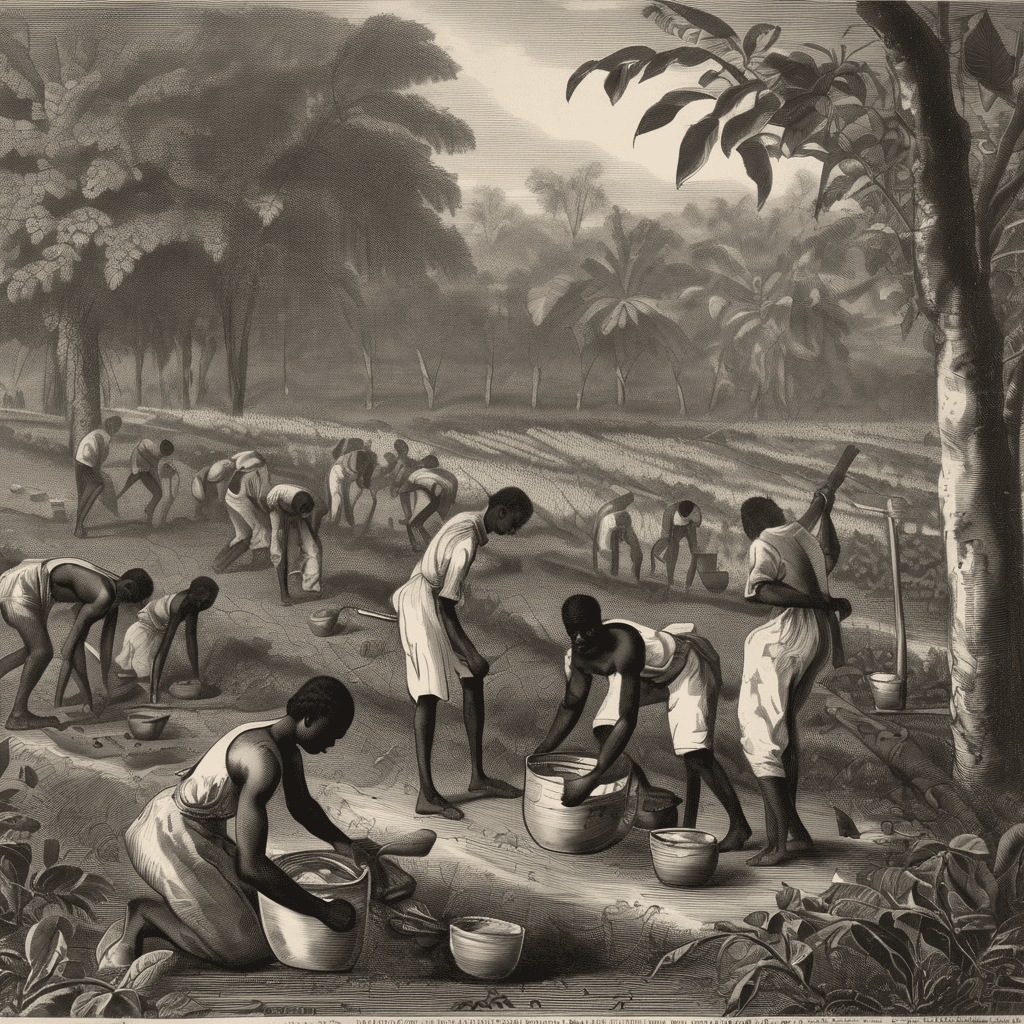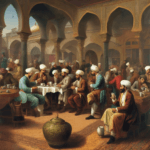While the aroma of coffee was filling European coffee houses with lively conversation and fueling intellectual pursuits, a darker side of its story was unfolding. The insatiable demand for coffee in Europe led to a brutal chapter in its history—one marked by colonial expansion, the exploitation of enslaved people, and the devastating transformation of entire landscapes.
Empire and Enslavement: The Bitter Truth Behind Coffee’s Rise
Driven by the pursuit of wealth and a thirst for coffee, European powers embarked on a ruthless campaign to establish coffee plantations in their colonies. The Dutch, French, British, and others employed various tactics to acquire coffee plants, including smuggling, theft, and even acts of espionage. They then established vast plantations across their colonies in the Caribbean, South America, and Asia.
This expansion came at a devastating human cost. The fertile lands of the Caribbean, South America, and Asia were transformed into sprawling plantations, fueled by the labor of millions of enslaved people. These individuals, forcibly removed from their homelands and subjected to unimaginable cruelty, became the backbone of the global coffee trade.
Stolen Lives, Stolen Lands: The Human Cost of Coffee
The human cost of coffee’s expansion is a stain on history. Millions of Africans were ripped from their homes, families, and cultures, forced onto slave ships bound for the New World. The Middle Passage, a treacherous journey across the Atlantic, was a nightmare of disease, starvation, and brutality. Countless souls perished in the cramped, unsanitary holds of these vessels, their bodies tossed overboard to be swallowed by the waves.
Those who survived the harrowing journey were sold into a life of abject misery on coffee plantations. They were branded, shackled, and subjected to a relentless regime of forced labor. Their days were filled with backbreaking toil under the scorching sun, their nights haunted by the fear of punishment and the longing for freedom.
The Caribbean: Islands of Sugar and Sorrow
Islands like Jamaica, Haiti, and Cuba, blessed with fertile soil and a tropical climate, became major coffee producers. However, this economic prosperity was built on the suffering of enslaved Africans. They toiled endlessly in the coffee fields, their lives a cycle of hardship, deprivation, and violence. They were denied basic human rights, their families torn apart, their spirits crushed under the weight of oppression.
On the island of Martinique, the plantation of Mount Pelée, owned by the wealthy merchant Gabriel de Clieu, became infamous for its brutal treatment of enslaved workers. Records from the 18th century document frequent whippings, mutilations, and even executions of those who dared to resist or defy their overseers. This brutality fueled uprisings, such as the 1757 slave revolt led by Polydor, which, though ultimately suppressed, sowed seeds of resistance that would later contribute to the Haitian Revolution.
Brazil: An Empire Built on Forced Labor
Brazil’s rise as a coffee superpower was similarly fueled by the exploitation of enslaved people. The Portuguese, who controlled Brazil, relied on a vast network of slave traders to supply the labor needed for their burgeoning coffee plantations. These traders captured and transported millions of Africans across the treacherous Middle Passage, where they endured horrific conditions and a high mortality rate.
Those who survived the journey were condemned to a life of hardship and toil in the coffee fields. The scale of enslaved labor in Brazil was staggering, dwarfing that of other coffee-producing colonies. It was a system where millions of stolen lives were consumed to fuel Brazil’s rise as a coffee superpower.
The Fazenda Paraíso in the Vale do Paraíba region of Brazil was one of the largest and most productive coffee plantations in the 19th century. Owned by the Baron of Jaguara, it relied on the forced labor of thousands of enslaved people who endured horrific conditions and brutal treatment. Despite the oppressive conditions, enslaved people on Fazenda Paraíso and other plantations found ways to resist, from subtle acts of sabotage to organized escapes and uprisings. The Quilombo dos Palmares, a self-governing community of escaped slaves, stood as a symbol of resistance for over a century.
From Seed to Commodity: The Erasure of Coffee’s Soul
As coffee production intensified under the plantation system, the focus shifted from quality and origin to quantity and profit. Coffee beans, once a treasured regional specialty, became a mass-produced commodity, their unique characteristics and the stories of the people who cultivated them obscured by the relentless pursuit of economic gain.
The Hidden Costs of Coffee: Blood, Sweat, and Environmental Degradation
The true cost of coffee during this era of expansion was hidden beneath the surface of its popularity. While Europeans savored their steaming cups in elegant coffee houses, oblivious to the suffering and sacrifice that went into producing those beans, a far different reality existed on the plantations. Enslaved laborers endured backbreaking work, often toiling from dawn till dusk under the harsh tropical sun. They faced hazardous conditions, including exposure to disease, dangerous wildlife, and the constant threat of violence from overseers. The environment, too, suffered as rainforests were cleared and soil depleted to make way for sprawling coffee plantations.
The clearing of the Atlantic Forest in Brazil for coffee cultivation resulted in the loss of vast biodiversity, including the extinction of numerous plant and animal species. The erosion of topsoil and contamination of rivers with agricultural runoff further degraded the environment, impacting local communities and ecosystems for generations to come. This environmental destruction continues to have repercussions today, with Brazil facing challenges such as water scarcity, soil degradation, and the loss of vital ecosystem services.
A Legacy of Inequality: The Long Shadow of Coffee’s Past
This era of coffee expansion left deep scars on both the people and the land. The environmental degradation and social injustices born from this period continue to impact the coffee industry today. Many coffee-producing communities still struggle with poverty, limited access to resources, and the lingering effects of colonial exploitation. The descendants of enslaved laborers often find themselves trapped in a cycle of poverty, denied the opportunities and resources needed to break free from the legacy of their ancestors’ suffering.
In countries like Guatemala and Colombia, where coffee production was historically reliant on forced labor, many indigenous communities continue to face discrimination, land dispossession, and limited access to education and healthcare. The legacy of colonialism continues to shape their social and economic realities. Furthermore, the global coffee trade is often characterized by unequal power dynamics, with small-scale farmers receiving a disproportionately small share of the profits, while multinational corporations control much of the market.
Brewing a Better Future: A Call for Ethical Coffee
Acknowledging this dark history is not about dwelling on the past; it’s about understanding the present and shaping the future. It’s a stark reminder of the urgent need for ethical and sustainable practices that prioritize the well-being of both people and the planet.
By consciously choosing fair trade coffee, supporting responsible sourcing, and advocating for environmentally conscious farming methods, we can help break the cycle of exploitation and create a more equitable and sustainable future for coffee. This means demanding transparency in the coffee supply chain, supporting businesses that prioritize ethical practices, and educating ourselves about the impact of our coffee consumption. Only then can we ensure that our love for coffee contributes to a better future for all.
What’s Next?
Understanding coffee’s troubled past inspires us to seek change. This sparked the Modern Coffee Revolution, prioritizing ethical sourcing and highlighting exceptional flavor. Ready to experience this difference? Explore this movement in Seed 101: IV. The Modern Coffee Revolution






No Comment! Be the first one.